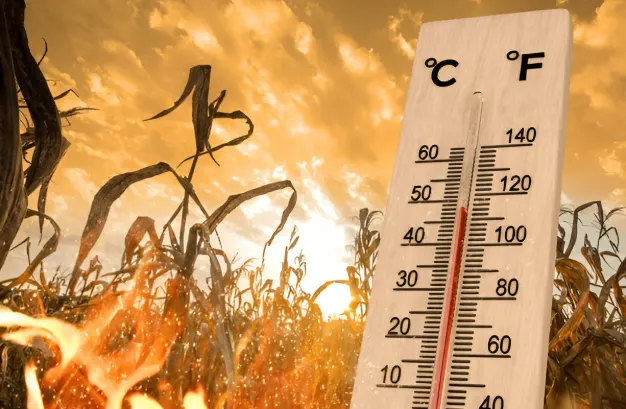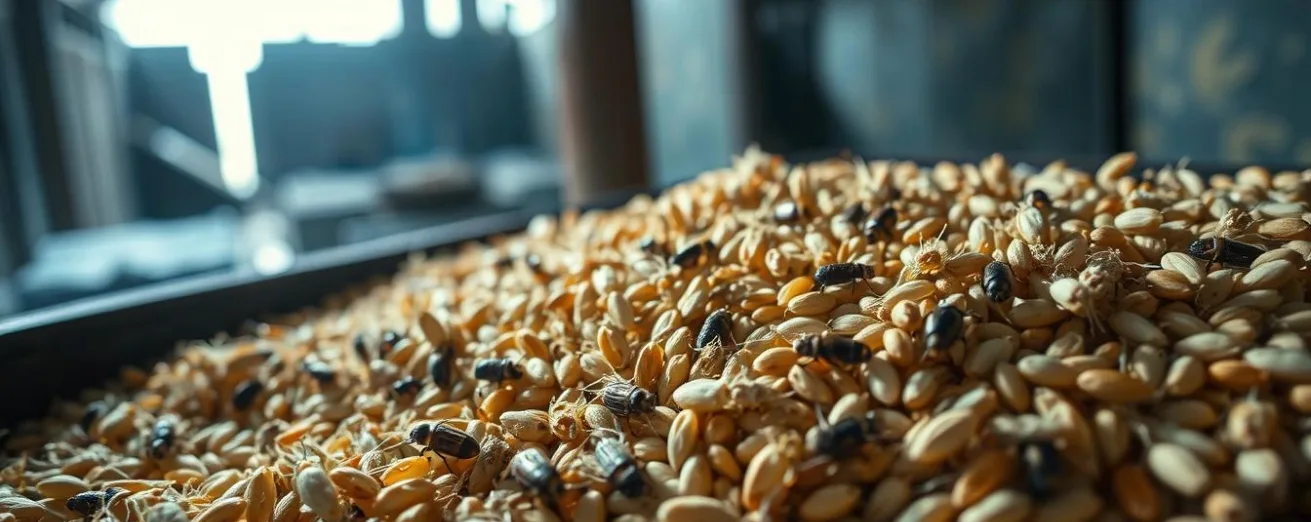What happens to your grain after harvest? For many in Indian agriculture, the answer is becoming more uncertain each season. Climate change is quietly making grain storage and preservation more difficult and risky. Heat, humidity, and erratic weather are now threatening the quality and safety of stored grains. It’s a growing problem, but not without solutions. This blog looks at the risks and explores strategies for Indian farmers, FPOs, and exporters for preserving their harvests in an increasingly volatile climate.
Climate Change & Its Agricultural Impact
Climate change is intensifying the risks in agriculture—droughts, floods, irregular rainfall, and heatwaves are becoming more frequent. These environmental changes don’t just affect crop production but also post-harvest grain storage. In India alone, about 22% of its food grain output is lost annually, which translates to a staggering 74 million tons. Prolonged exposure to high moisture levels and temperature fluctuations can lead to mold growth, spoilage, and pest infestations. In turn, these affect the agricultural supply chain, causing post-harvest losses in India that hurt both farmers and exporters alike.
How Climate Change Impacts Grain Storage and Quality
Unpredictable weather patterns caused by climate change are disrupting the ideal conditions for safe grain storage. With higher humidity and rising temperatures, grains absorb excess moisture, increasing the risk of fungal growth and storage pests in grains. In areas lacking temperature-controlled grain storage, this results in faster spoilage, reduced shelf life, and serious economic losses.
Stored grains need stable conditions—cool, dry, and pest-free. However, climate change accelerates grain degradation, reduces nutritional value, and raises contamination risks from aflatoxins. Exporters face more rejections due to poor grain quality at international borders, affecting food safety and marketability.
For example, wheat alone faces a 7.87% post-harvest loss due to moisture-related spoilage. Overall, post-harvest losses across the country cost around $18.5 billion annually. Without improved grain preservation in a changing climate, both domestic supply and agriculture export potential will suffer.
What Are the Most Common Storage Issues Caused by Rising Temperatures and Humidity?
Rising temperatures accelerate biochemical reactions in grains, causing faster spoilage. Meanwhile, excess humidity fosters fungal growth and pest infestations. Together, these factors contribute to major storage issues like mold, insect activity, weight loss, discoloration, and mycotoxin contamination. Traditional storage facilities struggle to control such variables, increasing post-harvest losses in India. Moisture control in grain storage is now one of the most urgent challenges facing Indian agriculture.
Can Traditional Godowns Handle the Effects of Climate Change on Grain Storage?
Most traditional godowns were built for stable climates—not the erratic and extreme weather we’re facing today. They often lack proper insulation, humidity control, or pest-proofing. As a result, grains stored here are more vulnerable to spoilage during periods of high humidity and heat. Unlike traditional godowns, Staragri’s state-of-the-art, temperature-controlled storage facilities are designed to tackle the challenges posed by erratic weather patterns. Staragri offers an efficient alternative that not only protects the grains but also helps extend their shelf life, ensuring both quality and marketability.
What Kind of Technology Can Help Protect Grain Storage from Climate-Related Damage?
Modern problems need modern solutions. Smart grain storage systems are now leveraging IoT in agriculture storage, automated ventilation, real-time digital grain monitoring systems, and temperature-controlled grain storage. These technologies help maintain ideal storage conditions and send alerts in case of deviations. They reduce human error, improve shelf life, and minimize spoilage. In today’s climate reality, agricultural warehousing solutions must integrate these tech upgrades.
How Can Small Farmers or FPOs Access Climate-Resilient Storage Facilities?
Cost-effective and accessible storage is critical for smallholder farmers and FPOs. Collaborating with third-party providers offering climate-resilient warehousing—like Staragri—can provide them access to scientific storage without the capital burden. Government-backed programs, warehouse leasing, or shared infrastructure models are also emerging, making FPO warehousing solutions in India more viable. Education on proper post-harvest grain storage practices also plays a key role here.
Are There Government Policies or Subsidies to Support Better Grain Storage Practices?
Yes, various government schemes in India are designed to support modern agri warehousing in India. These include capital subsidies for building scientific storage units, NABARD support for rural infrastructure development, and warehouse receipt financing under WDRA. Programs like PM Kisan SAMPADA also promote post-harvest solutions for Indian farmers. Leveraging these can significantly reduce storage-related losses and encourage climate-resilient warehousing development.
What Steps Can I Take Right Now to Make My Grain Storage More Climate-Resilient?
Start with the basics: control humidity, seal cracks to avoid pests, and avoid overloading your facility. Use moisture absorbers and ensure proper ventilation. Consider shifting to temperature-controlled grain storage or upgrading to scientifically managed warehouses. If that’s not possible, work with reliable storage partners who can help with modern grain storage techniques for farmers. Small actions now can protect your grain’s value later.
How Does Poor Grain Storage Affect Agri Exports?
Export-quality grains must meet strict international safety standards. Spoiled or pest-infested grains are often rejected, leading to major financial losses. Poor grain storage not only reduces quantity but also damages India’s global reputation in the agri exports market. Issues like aflatoxins or live insects in shipments can trigger long-term trade restrictions. Investing in proper grain preservation in a changing climate is vital for export success.
Who’s at Risk: Farmers, FPOs, Exporters
The ripple effect of poor grain storage due to climate change hits everyone—small farmers, FPOs, traders, processors, and agri exporters. Farmers face crop loss, FPOs risk financial strain, and exporters lose market opportunities. Grain storage problems in Indian climate require an urgent collective response from all levels of the agri ecosystem.
How It’s Impacting Grain Storage Challenges for Indian Farmers, FPOs & Exporters
For Indian farmers, monsoon excess or heatwaves result in unmanageable post-harvest losses. FPOs lack access to tech-enabled storage, while exporters struggle to meet quality checks. This challenge reflects a larger systemic issue in our agricultural supply chain—a gap between production and preservation. Addressing it requires affordable, accessible, and climate-resilient warehousing solutions across rural India.
Smart Storage Solutions in a Changing Climate
Adaptation is the key. Smart grain storage systems with automation, sensors, mobile alerts, and even AI-powered pest detection are no longer futuristic—they are now necessities. Companies offering agricultural warehousing solutions must shift from passive storage to active preservation using tech-enabled, sustainable models. Combining traditional wisdom with modern science can help build robust systems for the future.
How Staragri Can Help
At Staragri, we understand the challenges Indian farmers, FPOs, and exporters face in this era of climate uncertainty. That’s why we offer climate-resilient warehousing and temperature-controlled grain storage backed by modern tech. Whether you’re looking to reduce losses, meet export standards, or simply secure your harvest, Staragri provides end-to-end solutions tailored to your needs. From smallholder storage support to FPO warehousing solutions in India, we’re committed to safeguarding India’s grains—come rain or shine.
Conclusion
Climate change and grain storage are now deeply interconnected. Rising humidity, temperature swings, and unpredictable weather are no longer distant threats—they’re here, and they’re impacting every link in the agricultural value chain. The solution lies in awareness, technology adoption, and collective effort. Farmers, FPOs, exporters, and policymakers must unite to build a climate-resilient agricultural infrastructure. The grain we preserve today is the food security of tomorrow.




